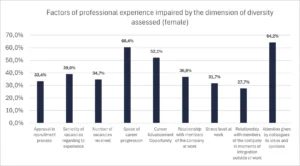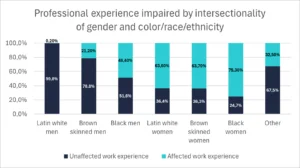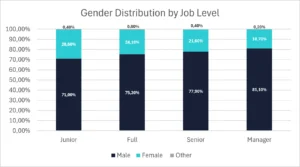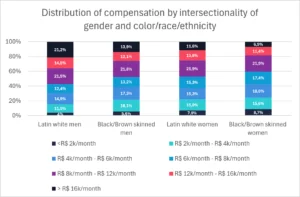The presence of women in the labor market is not just another workforce, but also thinking minds that bring inclusion and opportunities. In March 2019, NASA announced the first space mission with the exclusive participation of female astronauts. Christina Koch and Anne McClain were supposed to spend six hours at a space base installing lithium-ion batteries, but that didn’t happen. Despite the intention of giving opportunity to the women who make NASA’s day-to-day life happen, one basic detail prevented the mission from being carried out: the necessary clothing was not suitable for female bodies. The news was reported by the newspaper “El País” in the text “NASA cancels first spacewalk of two women due to lack of suits” (2019).
According to the CNN Brasil website, in the article “Women conquer space in the technology sector, but inequality still reigns” (2020), only 12.2% of jobs in the technology area are occupied by women. The fight to reduce gender inequality is not recent, but it must be constantly remembered and ensured. Women have been responsible for inventions and technologies that have revolutionized society, and their active role remains indispensable today.
Historical participation and female importance in I.T.
Ada Lovelace was the first person to have a notable role in technology, being considered the first programmer in the world. She was active in the development of the analytical engine and described what is now recognized as the first algorithm capable of being processed by a computer. Many later technological studies were only possible thanks to his discoveries.
In addition to being notable inventors, such as Hedy Lamarr (who set the foundation for the development of Wi-Fi technology) and Margaret Heafield Hamilton (who developed the flight program used in the Apollo 11 project), women bring a greater diversity of perspectives. This is because women have particular experiences, which lead to different lines of thought and, consequently, to new ideas and solutions. This scenario becomes even more relevant when we consider that technological problems reflect different aspects and demands of different social groups.
“There is social pressure about women’s behavior, which is why breaking stereotypes is so important. Within the work environment, it is necessary to use the different skills that each one has, highlighting the best they have and what they can contribute.”
– Lucia Cleia, IT and Business Coordinator at Klabin.
Women in science in numbers
The study “An x-ray of data professionals in Brazil“, published by Data Hackers in 2024, highlights an often ignored reality: Brazil is still far from treating women the same way it treats men.
Fifty-eight percent of female respondents report that their experiences are affected already in the job search phase. The reasons most cited in the survey include the number of vacancies that come to them, the speed and opportunities for career progression, and especially the attention received by co-workers on a daily basis in relation to their opinions and ideas.

The essay goes even deeper and understands the difference between work experiences in the area by other diversity factors, such as ethnicity:

Regarding the career opportunity, the study shows a picture of the positions held by genders, considering the data panorama in the country:

When it comes to remuneration, it is evident that the pattern of inequality remains (here the effect of the intersectionality of gender and color/race/ethnicity is also considered):

This reality, however, is not a static photo. It is the consequence of a long journey that humanity chooses to trace, each time it reinforces a stereotype, invented by itself.
Stigmas that set society back
Women’s low adherence to technology can be explained by several reasons. A study carried out in universities in Mexico, entitled “STEAM as a tool to encourage engineering studies” (2019), shows that the reasons for the underrepresentation of women are present since higher education. Among them are:
- Hostile environments and cultural pressure to adjust to traditional gender roles;
- Doubts, both from third parties and one’s own, about the personal ability to perform tasks;
- Absence of female role models to be followed in science and engineering;
- Domination of the male vision in the development of projects.
“The IT market is mostly dominated by the male gender, in this scenario women need to prove their worth, often needing to show their knowledge, their competence to break the resistance of men who are not used to being led by women.”
– Lucia Cleia, IT and Business Coordinator at Klabin
These stigmas have a cultural origin. Throughout the history of sexuality, the notion has been constructed that men are more “technical” and “logical”, while women are more “emotional” and “careful”. According to the article “Masculinity in history: the cultural construction in the difference between the sexes” (2000), men’s activities were directed to the social, political and economic world, while women’s were restricted to the domestic environment.
With the arrival of “modern times”, women conquered space in the labor market, but they could not give up domestic responsibilities. This resulted in a double, or even triple, workday, because in addition to working and taking care of the house, they needed to remain competitive and seek constant qualification. This impact was reflected in all areas, including IT, which is still predominantly male today.
“What prevented me from studying and working in the IT area earlier was the stigma that I was not enough for being a woman. Society leads women to believe that men are more skilled, more logical.”
– Michele, ST-One Tech Team
“Where are these people who are part of society, but are not here yet?”
According to the article “Factors that attract and keep girls away from courses in the area of I.T.” (2019), the reasons that attract women to the field of technology include: interest in computer science concepts, their practical application (how to solve problems and make a positive impact with the knowledge acquired), as well as social and cultural issues (need to challenge stereotypes applied to women and computer science).
Despite the growing interest in the area, there is still much to be done to increase the female presence in IT positions. Companies play an indispensable role in this process of conquering more space. Some actions that can be implemented include:
- Use inclusive language when opening vacancies, making it clear that the company is open to diversity;
- Highlight women working in the technology area;
- Encourage the training of female professionals for the technology market, through education, content and networking programs;
- Establish career plans with greater female protagonism, aiming at leadership positions;
- Ensure the participation of women in key positions in the decision-making process.
“I realized the need to look at the team, regardless of where I worked, and realize how it was in terms of diversity. When it comes to vacancies for the Tech area, I think ‘Where are these people who are part of society, but are not here yet?’. So, in the processes in which I am a part, I already open with a focus on trying to repair these inequalities caused by the structure of our culture”
– Larissa, ST-One team of people (click here to find out about ST-One job openings).